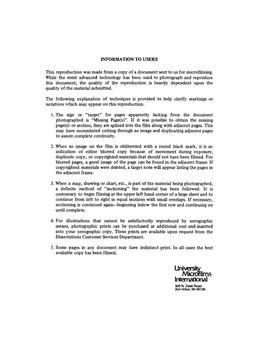| dc.contributor.author | Sammy, George K. | en_US |
| dc.date.accessioned | 2013-08-16T12:28:51Z | |
| dc.date.available | 2013-08-16T12:28:51Z | |
| dc.date.issued | 1982 | en_US |
| dc.identifier.uri | https://hdl.handle.net/11244/5093 | |
| dc.description.abstract | This study was conducted to determine the status of Environmental Impact Assessment (EIA) in developing countries; to review assessment methods developed for use in industrialized countries; and to identify methods or salient features of methodologies which are applicable to EIA in the third world. These objectives were achieved through correspondence, computerized database searches and a literature review, an international mail questionnaire, statistical testing and application of a selection procedure to compare methods. The questionnaire consisted of five parts: personal data, current status of EIA, environmental parameters, EIA methodologies, and miscellaneous. It was sent to 700 persons in 139 developing countries and 300 persons in 25 industrialized countries. | en_US |
| dc.description.abstract | Replies were received from more than 150 persons in 72 developing countries and more than 150 persons in 22 industrialized countries. These responses were analyzed and a series of conclusions and recommendations were made. First, EIA is recommended as a planning tool that should be used in developing countries. There was nothing mentioned in the responses which would preclude its use. Second, a conceptual framework for EIA in developing countries is proposed. The basic steps are preliminary activities, impact identification (scoping), baseline survey, impact evaluation, mitigation planning, comparison of alternatives, decision-making and post-auditing. | en_US |
| dc.description.abstract | In addition to these general results, there were several more specific findings, as follows: (a) The growth of EIA has been rapid in both developing and industrialized countries. (b) A majority of countries had laws requiring EIA, and an even larger majority had conducted EIAs. (c) The unavailability of data and expertise are among the problems hampering EIA in developing countries. (d) Checklists and matrices are among the most appropriate methodologies for identifying impacts and comparing project alternatives in developing countries at the present time. (e) When evaluating impacts, quantitative assessments are superior to descriptive ones. (f) The view that public involvement is not encouraged in the third world and that socio-economic factors are rated most important in developing areas were not supported. | en_US |
| dc.format.extent | xviii, 503 leaves : | en_US |
| dc.subject | Political Science, Public Administration. | en_US |
| dc.title | Environmental Impact Assessment in developing countries. | en_US |
| dc.type | Thesis | en_US |
| dc.thesis.degree | Ph.D. | en_US |
| dc.thesis.degreeDiscipline | School of Civil Engineering and Environmental Science | en_US |
| dc.note | Source: Dissertation Abstracts International, Volume: 43-11, Section: A, page: 3704. | en_US |
| ou.identifier | (UMI)AAI8306747 | en_US |
| ou.group | College of Engineering::School of Civil Engineering and Environmental Science | |
